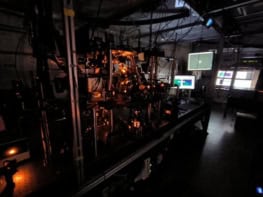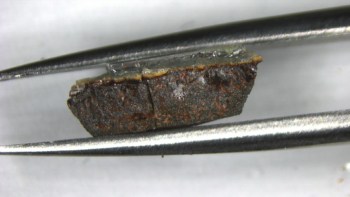
Taking inspiration from the flow of air around aeroplane wings, researchers in the US have imaged photoexcited electrons flowing around sharp bends for the first time. Because such bends are often found in integrated optoelectronic circuits, observing the electrons’ “streamlines” could lead to improvements in circuit design.
More than 80 years ago, the physicists William Shockley and Simon Ramo showed theoretically that when electrons travel around bends, their streamlines get locally compressed, producing heat. Until now, though, no-one had measured this effect directly because it is so difficult to observe the streamlines of electron photocurrents – that is, electric currents induced by light – through a working device.
In the new work, which is described in the Proceedings of the National Academy of Sciences, researchers led by physicists Nathaniel Gabor and David Mayes of the University of California, Riverside built a micromagnetic heterostructure device made from a layer of platinum on a yttrium iron garnet (YIG) substrate and placed it in a rotating magnetic field. They then directed a laser beam onto the YIG, causing the device to heat up and triggering a phenomenon known as the photo-Nernst effect. It is this effect that generates the photocurrent.
Observing the overall pattern of streamlines
By changing the direction of the external magnetic field, the team “inject the current in such a way that we not only control its source location, but also its direction,” explains Mayes. What is more, he adds, “it turns out that when you measure the electronic response as you do this over and over, you end up observing the overall pattern of streamlines.”
To demonstrate the power of their technique, the researchers repeated the experiments on a modified device called an electrofoil that enabled them to contort, compress and expand the photocurrent streamlines in the same way that aeroplane wings contort, compress, and expand the flow of air. In both scenarios, the streamlines represent the direction of flow that yields the greatest response at each point, as predicted by Shockley and Ramo’s theorem.
“Back in the late 1930s, these two eminent physicists realized that a free charge in a device does not have to reach an electrode to induce an electric response,” Mayes tells Physics World. “Instead, the motion of the free charges will affect all the other charges in the device due to the Coulomb force.
“Shockley and Ramo were able to show that the streamlines not only illustrate the ‘preferred’ current direction for the device, but that they also represent the pattern of current flow through it as if we had simply biased one end of the device and grounded the other.”
Avoiding hot spots
Gabor notes that being able to determine where current flow lines are being compressed in a device could help circuit designers avoid creating such local hot spots. “The results from our study also suggest that you should not have sharp bend features in your electrical circuit,” he says, adding that gradually curving wires are “not the state-of-the-art right now”.

Electrons heat up in first observation of spin Nernst effect
The researchers are now exploring ways of increasing the resolution of their technique while also testing new devices and materials. In particular, they would like to measure streamlines in devices fashioned into geometries such as a “Tesla valve”, which constrains electron flow in one direction.
“Our measurement tool is a powerful way to visualize and characterize charge flow optoelectronic devices,” says Gabor. “We hope to advance our ideas towards new emerging materials that include both magnetic Nernst-like effects and unconventional current flow behaviour.”



